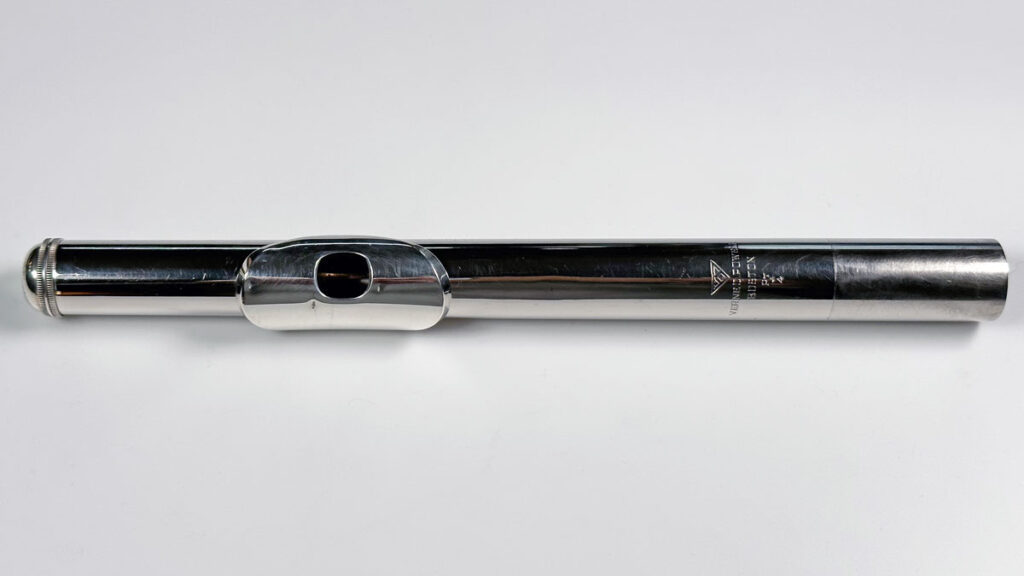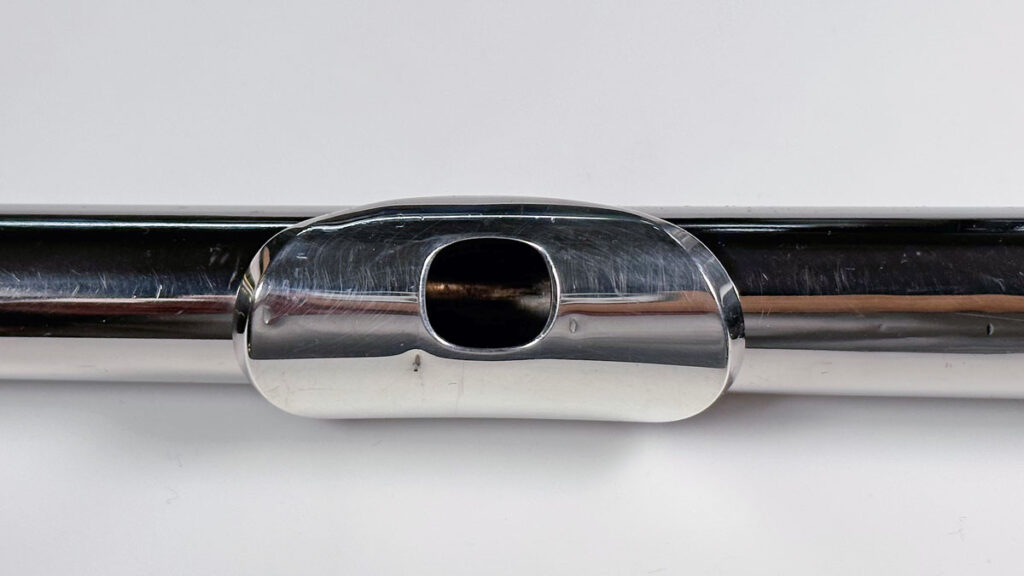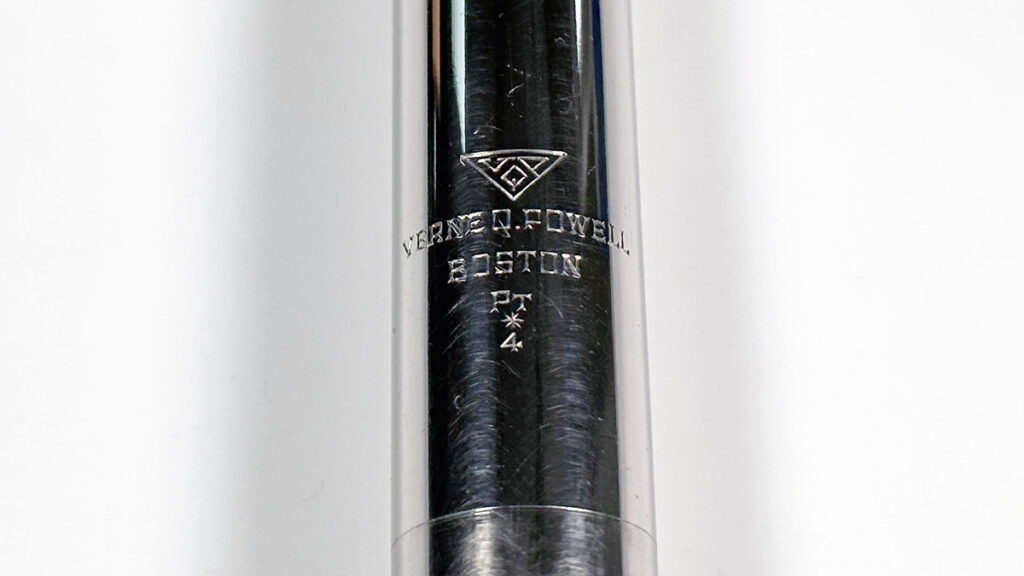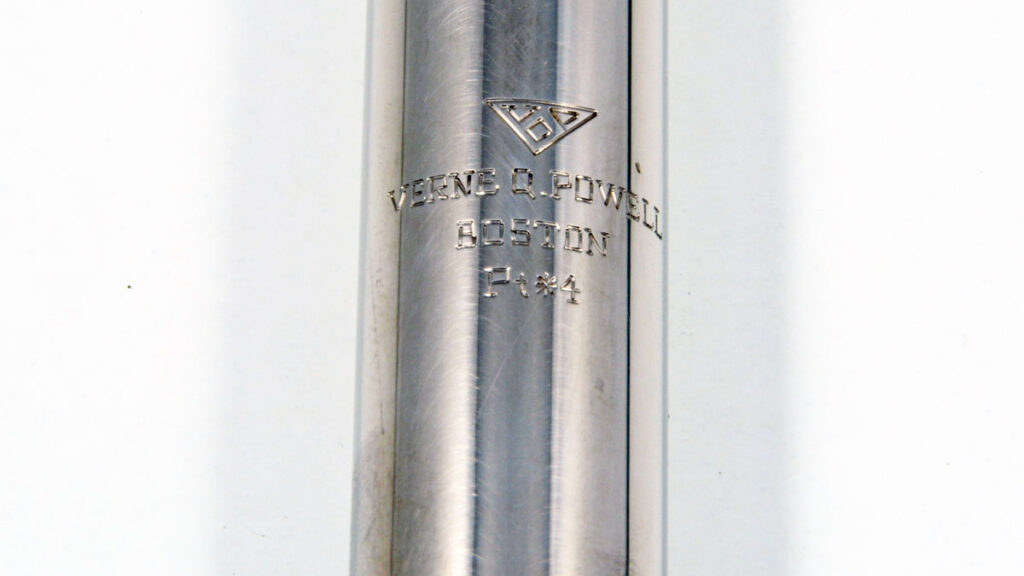- Made in 1988.
- Platinum, ruthenium, iridium, and palladium tubing
- 0.014″ tubing
- Silver lip plate and crown
- 14K gold riser
- Embouchure: 10.42 mm x 11.69 mm
- Embouchure height: 0.191″
- Sounding length: 151.2 mm
- Weight: 91 g
In a word – exotic. This is one of the rarest headjoints of unique metallurgy in which the tubing contains four metals of the platinum family – platinum, rhodium, ruthenium, and palladium. The tubing was formed in two layers, similar to Aurumite headjoints. Each layer is an alloy of two of the metals. (Platinum and ruthenium are in one layer; iridium and palladium are in the other.) The lip plate, riser, and crown are made of sterling silver. Powell made only 10 of these headjoints. This particular headjoint was the first ever made and was purchased at the National Flute Convention in 1988 by the current owner.
In the words of Steven Finley, who was at Powell when Pt*4 was in production, the sound of these headjoints has “the lustrous quality of silver and the elusive mercurial specialness of platinum.” Producing the tubing was exceedingly challenging and expensive, so only a small number were ever made. (Walfrid Kujala played one of these headjoints in the Chicago Symphony.)
In our testing of this headjoint on various flutes, the sound is as Steven describes. It is one of the most energetic headjoints we’ve come across. It’s gutsy and loves to play loudly. Very loudly. There’s also a brilliance that makes the sound shine and effortlessly penetrate throughout the concert hall. This headjoint can take a lot of air and allows you to dig into the low notes without cracking. This is a very special headjoint!
Besides its unique metallurgy, this headjoint has an unfortunate history, but with a happy ending. The owner had paired this headjoint with her Powell flute, 1655. In 1992, she was mugged, and her prized flute was stolen. For 26 years, the flute (with the Pt*4 headjoint) went missing. It wasn’t until 2018 that she received a phone call from a representative at Powell letting her know that someone found her flute!
As it turned out, the flute was purchased by another woman at a flea market for a whopping $75! The woman who purchased it didn’t know the value of the flute, nor did she know how to play it. Her son-in-law, however, was a clarinetist. He researched the Powell brand name and contacted the company to learn more about the flute. They told him the instrument was stolen, and he was more than happy to return the flute to its rightful owner. Powell then took his information and notified the owner, who was soon reunited with her long-lost friend. (You can read an article about it.)
The flute was insured, and the owner contacted her insurance company about its recovery. The insurance company has a policy of discharging ownership of an instrument after 20 years if it remains unrecovered. Since the recovery happened 26 years after it was reported stolen, the owner was allowed to keep the flute.
She has since overhauled the flute with gold Schmidt pads and has enjoyed playing it for the past several years. As it happens in many musicians’ careers, there is a time when it’s time to find new homes for their instruments. Since the headjoint is not original to 1655, it is being sold separately.
During its absence, the headjoint had experienced a few minor nicks on the lip plate. In most instances, removing these nicks is possible. However, doing so would require removing the lip plate from the tubing (using high heat to soften the solder). Given the rarity of this headjoint, Gary Lewis decided not to risk damaging the tubing. Furthermore, these blemishes are not near the embouchure and do not at all affect the resonance and playability of the headjoint. For these reasons, we recommend leaving the lip plate in its current condition.
SOLD




